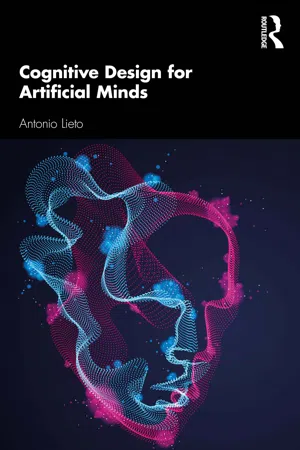
Cognitive Design for Artificial Minds
Antonio Lieto
- 152 Seiten
- English
- ePUB (handyfreundlich)
- Über iOS und Android verfügbar
Cognitive Design for Artificial Minds
Antonio Lieto
Über dieses Buch
Cognitive Design for Artificial Minds explains the crucial role that human cognition research plays in the design and realization of artificial intelligence systems, illustrating the steps necessary for the design of artificial models of cognition. It bridges the gap between the theoretical, experimental, and technological issues addressed in the context of AI of cognitive inspiration and computational cognitive science.
Beginning with an overview of the historical, methodological, and technical issues in the field of cognitively inspired artificial intelligence, Lieto illustrates how the cognitive design approach has an important role to play in the development of intelligent AI technologies and plausible computational models of cognition. Introducing a unique perspective that draws upon Cybernetics and early AI principles, Lieto emphasizes the need for an equivalence between cognitive processes and implemented AI procedures, in order to realize biologically and cognitively inspired artificial minds. He also introduces the Minimal Cognitive Grid, a pragmatic method to rank the different degrees of biological and cognitive accuracy of artificial systems in order to project and predict their explanatory power with respect to the natural systems taken as a source of inspiration.
Providing a comprehensive overview of cognitive design principles in constructing artificial minds, this text will be essential reading for students and researchers of artificial intelligence and cognitive science.
Häufig gestellte Fragen
Information
1
Cognitive science and artificial intelligence
AbstractThe first chapter proposes a brief historical overview of some of the main insights developed over 65 years of research in Artificial Intelligence (AI), by introducing the early vision of the discipline (based on a mutual collaboration with Cognitive Psychology) and its “paradigm shift”, which started from the mid-1980s of the last century. Starting from that period on, AI and the interdisciplinary enterprise known as Cognitive Science started to produce several sub-fields, each with its own goals, methods, and criteria for evaluation. The reasons for the current renewed interest of a cognitively inspired approach in AI research are discussed.
When Cognitive Science was AI
From the general problem-solver to the society of mind: cognitivist insights from the early AI era
Inhaltsverzeichnis
- Cover
- Half Title
- Title Page
- Copyright Page
- Table of Contents
- List of illustrations
- Introduction
- Acknowledgements
- Dedication
- 1 Cognitive science and artificial intelligence: death and rebirth of a collaboration
- 2 Cognitive and machine-oriented approaches to intelligence in artificial systems
- 3 Principles of the cognitive design approach
- 4 Examples of cognitively inspired systems and application of the Minimal Cognitive Grid
- 5 Evaluating the performances of artificial systems
- 6 The next steps
- References
- Index